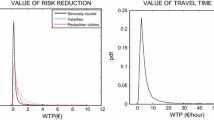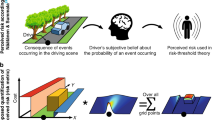Abstract
The theory of risk homeostasis has been put forward as a tentative explanation for a jurisdiction’s traffic accident rate per km, per hour of road-user exposure, and per capita, as well as their pattern of interrelations. According to this theory, the accident rate per time unit of expo-sure is the end product of a homeostatic control process in which the level of risk accepted by the road user population—in return for the benefits accruing from their manner and amount of mobility—functions as the regulating variable. Although the real-life data lending support to this theory are many and varied, there is a lack of controlled experimental verification. The latter meets with obstacles of two kinds: inherent shortcomings of laboratory studies for the investigation of human behavior, and complications arising from the nature of the theory itself.
In an attempt to elicit risk-taking behavior under well-controlled conditions, an experiment was designed to explore a number of questions related to the theory in question. Individual subjects on their own played a simple “video game” for real money and were faced with two sources of risk: (a) uncertainty due to limitations in their own psychomotor skill and (b), in case of failure to meet a criterion of performance, the risk of financial loss which was externally controlled (by the experimenter) at two different levels of probability. The findings appear to lend partial support to RHT: the amount of money earned was independent of the subject’s skill; behavioral compensation occurred in relation to the two sources of risk, but not complete homeostasis.
Access this chapter
Tax calculation will be finalised at checkout
Purchases are for personal use only
Preview
Unable to display preview. Download preview PDF.
Similar content being viewed by others
References
Adams, J.G.U. The Efficacy of Seat Belt Legislation. SAE Technical Paper Series, 1982, No. 820819, 12–15.
Adams, J.G.U. Public Safety Legislation and the Risk Compensation Hypothesis: The Example of Motorcycle Helmet Legislation. Environment and Planning C: Government and Policy, 1983, 1, 193–203.
Chapanis, A. The Relevance of Laboratory Studies to Practical Situations. Ergonomics, 1967, 10, 557–577.
Cownie, A.R. An Operational Game for the Study of Decision Making in a Hazardous Activity. Accident Analysis and Prevention, 1970, 2, 1–10.
Evans, L. Wasielwski, P. and von Buseck, C.R. Compulsory Seat Belt Usage and Driver Risk-Taking Behavior. Human Factors, 1982, 24, 41–48.
Graham, J.D. Comment on Wilde’s “Theory of Risk Homeostasis.” Risk Analysis, 1982, 2, 235–237.
Hauer, E. Selection for Treatment as a Source of Bias in Before-After Studies. Traffic Engineering and Control. Aug./Sept., 1980.
Huguenin, R.D. Zur Problematik von Risikohomoeostasetheorien in der Ver- kehrspsychologie. Zeitschrift fuer Verkehrssicherheit, 1982, 28, 180–187.
Jackson, D.N., Hourany, L. and Vidmar, N. A Four-Dimensional Interpretation of Risk Taking. Journal of Personality, 1972, 40, 483–501.
Lund, A.K. and Zador, P. Mandatory Belt Use and Driver Risk Taking. Risk Analysis, 1984, 4, 41–53.
McKenna, F.P. The Human Factor in Driving Accidents: An Overview of Approaches and Problems. Ergonomics, 1982, 25, 867–877.
Mittenecker, E. Methoden und Ergebnisse der psychologischen Unfallforschung. Vienna, Austria: Deuticke, 1982.
Naatanen, R. and Summala, H. A Simple Method for Simulating Danger- Related Aspects of Behavior in Hazardous Activities. Accident Analysis and Prevention, 1975, 7, 63–70.
Orne, M.T. On the Social Psychology of the Psychology Experiment: With Particular Reference to Demand Characteristics and their Implications, American Psychologist, 1962, 17, 776–783.
Orr, L. Goals, Risk and Choices. Risk Analysis, 1982, 2, 239–242.
Rosenthal, R. Experimenter Outcome-Orientation and the Results of the Psychological Experiment. Psychological Bulletin, 1964, 61, 405–412.
Slovic, P. and Fischhoff, B. Comment on Wilde’s “Theory of Risk Homeostasis.” Risk Analysis, 1982, 2, 227–234.
Veling, I.H. A Laboratory Test of the Constant Risk Hypothesis. Acta Psychologica, 1984, 55, 281–294.
Wilde, G.J.S. A Psychological Study of Drivers’ Concern For Road Safety and their Opinions of Various Public Policy Measures Against Drinking and Driving. Proceedings, Seventh International Conference on Alcohol Drugs and Traffic Safety, Melbourne, Australia, January 23-28, 1977, pp. 410–424.
Wilde, G.J.S. Theorie der Risikokompensation der Unfallverursachung und praktische Folgerungen fuer die Unfallverhuetung. Hefte zur Unfallheilkunde, 1978, 130, 134–156.
Wilde, G.J.S. The Theory of Risk Homeostasis: Implications for Safety and Health. Risk Analysis, 1982a, 2, 209–225.
Wilde, G.J.S. Critical Issues in Risk Homeostasis Theory. Risk Analysis, 1982b, 2, 249–258.
Wilde, G.J.S. On the Choice of Denominator for the Calculation of Accident Rates. In S. Yagar (ed.) Risk in Transport, University of Waterloo Press, Waterloo, Ontario, 1984, 1984a.
Wilde, G.J.S. Evidence Refuting the Theory of Risk Homeostasis? A Rejoinder to Frank P. McKenna. Ergonomics, 1984b, 27, 297–304.
Wilde, G.J.S. Homeostatic Mechanisms in the Causation of Mortality due to Traffic Accidents and Lifestyle-Dependent Disease. Proceedings, Third Inter-national Conference on System Science in Health Care, Munich, F.R. Germany, July 16–20, 1984b, pp. 342–345.
Wilde, G.J.S. Homeostatic Mechanisms in the Causation of Mortality due to Traffic Accidents and Lifestyle-Dependent Disease. Proceedings, Third Inter-national Conference on System Science in Health Care, Munich, F.R. Germany, July 16–20, 1984b, pp. 342–345.
Wilde, G.J.S. and Murdoch, P.A. Incentive Systems for Accident-Free and Vio- lation-Free Driving in the General Population. Ergonomics, 1982, 25, 879–890.
Wilde, G.J.S. O’Neill, B. and Cannon, D. A Psychometric Investigation of Drivers’ Concern for Road Safety and Their Opinions of Various Measures for Accident Prevention. Queen’s University, Studies of Safety in Transport, Kingston, Ontario, 1975.
Wilde, G.J.S. und Kunkel, E. Die begriffliche und empirische Problematik der Risikokompensation. Eine Erwiderung auf Dr. R.D. Huguenin. Zeitschrift fuer Verkehrssicherheit, 1984, 30, 52–62.
Zuckerman, M. Dimensions of Sensation Seeking. Journal of Consulting and Clinical Psychology, 1971, 36, 45–52.
Author information
Authors and Affiliations
Editor information
Editors and Affiliations
Rights and permissions
Copyright information
© 1985 Plenum Press, New York
About this chapter
Cite this chapter
Wilde, G.J.S., Claxton-Oldfield, S.P., Platenius, P.H. (1985). Risk Homeostasis in an Experimental Context. In: Evans, L., Schwing, R.C. (eds) Human Behavior and Traffic Safety. Springer, Boston, MA. https://doi.org/10.1007/978-1-4613-2173-6_7
Download citation
DOI: https://doi.org/10.1007/978-1-4613-2173-6_7
Publisher Name: Springer, Boston, MA
Print ISBN: 978-1-4612-9280-7
Online ISBN: 978-1-4613-2173-6
eBook Packages: Springer Book Archive




